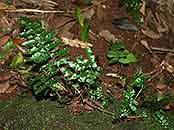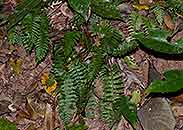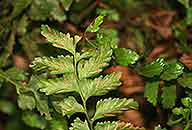Asplenium inaequilaterale Willd.
Synonyms |
Asplenium laetum sensu Sim |
|---|---|
Common name |
|
Description |
Rhizome erect, up to 8 mm diameter; rhizome scales 2-3 x 0.6 mm, dark brown, entire, lanceolate in outline, apex tapering to a point. Fronds not proliferous, tufted, erect, herbaceous. Stipe up to 19 cm, stipe and rhachis pale to dark matt brown, hairless at maturity. Lamina 12-32 x 4-13 cm, pinnate and narrowly triangular-ovate in outline, lower pinnae not markedly reduced; apical segment lobed, crenate, tapering to a point. Pinnae 8-20 pairs, narrowly oblong to roughly lanceolate in outline, sometimes falcate, shortly petiolate, 1.5-6.3 x 0.7-1.2 mm, glabrous, base asymmetric with a well developed acroscopic lobe, apex acute, margins irregularly crenate. Sori 3-16 pair, linear, situated on each pinnae at 45 degrees to the costa, 2-7 mm long; indusium entire, membranous, linear to oblong, 0.5-1 mm wide. |
Notes | Differs from similar species by not having basal pinnae reducing in size, base strongly asymmetrical but the midrib does not form the lower margin for a significant distance. |
Derivation | inaequilaterale: unequally sided, the pinnae bases of this species are asymmetric. |
Habitat | Deep shade in moist evergreen forest. Terrestrial or lithophyte. |
Distribution worldwide | Africa, Comoro Is., Réunion. |
Distribution in Africa |
Angola, Burundi, Cameroon, Central African Republic, Dem. Republic of Congo, Equatorial Guinea (incl. Bioko), Ethiopia, Gabon, Ghana, Guinea, Kenya, Liberia, Malawi, Mozambique, Rwanda, Sierra Leone, South Africa, Sudan and South Sudan, Swaziland, Tanzania , Togo, Uganda, Zambia, Zimbabwe. |
Growth form |
Lithophytic, terrestrial. |
Literature |
|




